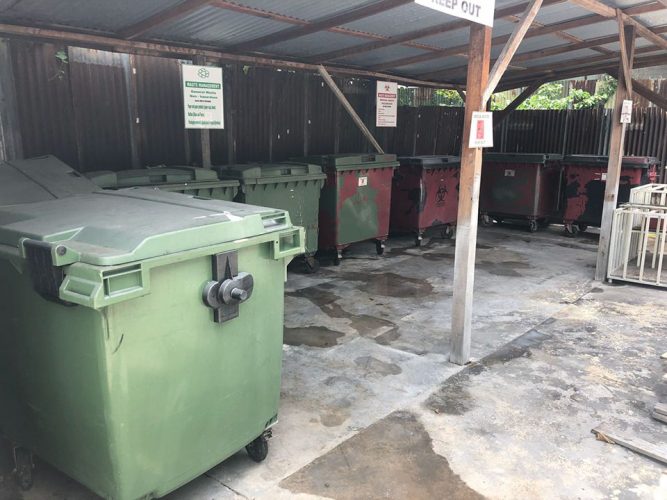A team from the Environmental Protection Agency (EPA) yesterday visited the Woodlands Hospital in Carmichael Street following complaints from residents about the careless disposal of medical waste.
The EPA team is to make recommendations.
Yesterday, Woodlands deflected responsibility for the haphazard handling of medical waste and blamed it on the manner of collection by the disposal service it has hired.
Administrator of the Hospital Deonarine Memraj told Stabroek News yesterday that the hospital follows a rigid methodology and policy with regards to disposing of its waste and the reports of haphazard disposal might have stemmed from the way the hospital’s waste is handled by the Waste Management service of the Georgetown Public Hospital (GPH).
From pictures that were seen and published by Stabroek News yesterday, bags of medical waste were overloaded in a dumpster with blood smeared around the yard. There were also used syringes and broken vials on the passageway that residents use to access their homes. A disposable bin, filled with red bags of medical waste, was also seen peeking over the hospital’s storage site’s gate.
“With respect to the report that is solely because of the fact that Waste Management workers [attached to the Georgetown Public Hospital] and the way they are when they are collecting our waste and how they handle it,” Memraj said.
He explained that they pay the hospital per bag of waste that is collected every Thursday and since their storage facility is at the eastern end of a long passageway, where residents reside on both ends, the disposal vehicles are unable to stop directly in front of their gate.
As a result, the workers would have to load the waste into their own receptacles before they take them along the walkway to the vehicle, which often results in waste being left on the ground.
“One of the reasons they transfer is because they account for each bag and that’s how they bill you. They are not allowed to come into the passageway to collect it so they have to bring in their own container and offload from outside into their container and then take it back to their trucks,” he explained.
Memraj said that they have raised the issue before with the GPH and have requested that the collection be done twice a week instead of once.
“…But from their end, that was not feasible. They don’t see it as feasible to pick it up twice a week and that is what we were told,” he said, while noting that the hospital would prefer if its waste could be disposed of daily, which it is willing to pay for.
It has been noted that whether the disposal service is defective or not, Woodlands would still be accountable as it is its waste that has been strewn in the area and it does have a responsibility to ensure that a proper clearing of the waste is done.
Memraj also explained that after a similar issue in 2015, the EPA intervened and made several recommendations, a majority of which were acted upon.
“The EPA recommendations were that we ensure that the area is well secured and that the area of collection had a shed and it is kept in a cool environment, which means they wanted us to enclose and air-condition it. We did all the above except the air-conditioning,” he said, while stating that even though it would be costly to air-condition the area, they will consider it in the future.
A team from the EPA also visited the hospital yesterday and did an inspection of the company’s waste disposal policy and system.
Stabroek News was also taken on a tour of the facilities and was shown how the hospital sorts and disposes of its waste.
It was explained that the biohazard, non-biohazard and sharp waste, are all separated into small receptacles that are equipped with colour coded garbage bags at every Unit. Sharp waste, such as needles and used vials, is first placed in containers before they are taken to the storage area. The bags are then doubled and taken to the storage site by trained personnel equipped with the relevant gear.
When the waste is taken to the site, it is sorted again and the biohazard, non-biohazard and sharp waste are stored in different receptacles. There, they wait until Thursday, when the GPH workers take them away.
The residents had also complained about the smell emanating from the storage area and Memraj said that they ensure it is cleaned with the necessary disinfectant every morning.
“If the residents are willing to allow access to the area, then I think it will help in the way the waste is being managed,” he said, while emphasising that they have a strict methodology and policy that is not strayed from.
The EPA team also noted that they will be making some recommendations and will be working towards ensuring that there are more frequent pickups by the GPH.














